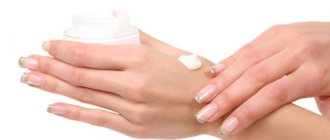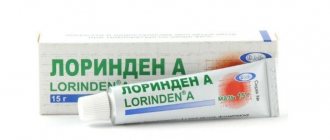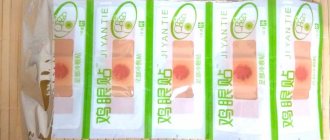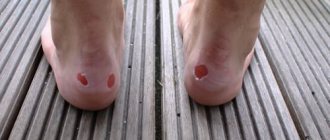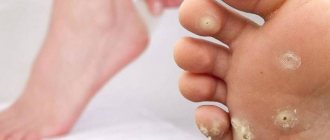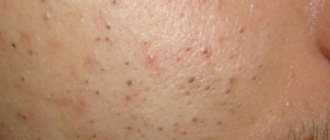Causes and symptoms of calluses between toes
Human skin always reacts to traumatic effects.
Calluses are a specific skin reaction that manifests itself in the form of a bubble or a dense keratinized area. The variety of types of calluses is great, and almost every one requires treatment. How troublesome and time-consuming it will be depends on how timely the help was. Calluses between the toes, wet or dry, appear due to a number of factors acting separately, alternately or together. The most common reasons are the following:
- pressure and friction due to ill-fitting or hard shoes;
- wearing high heels for a long time;
- joint diseases - arthritis, arthrosis or gout;
- swelling of the limbs due to heart or kidney disease;
- excess weight;
- flat feet;
- crooked fingers.
The impact of one or another factor leads to the fact that the skin in the injured area undergoes qualitative changes. How to treat calluses on feet from shoes, read the link. Most often, a bubble first forms, consisting of stratified tissues and intercellular fluid between them. With continued pressure or friction, the area begins to dry out and harden. This is how the body protects itself from injury. The most dangerous form of callus is considered to be ingrown (core), which is a continuation of dry callus and poses a serious threat to health.
The symptoms of any callus are quite similar. They cause pain when pressed, rubbed, or even at rest. And at the same time, each callus between the toes has its own distinctive features - the cause of its appearance, the nature of the neoplasm, the intensity of pain.
Why do calluses appear on feet?
Corns between the toes can appear for a variety of reasons. For proper treatment, it is necessary to understand what causes its formation, since the correctness of the chosen strategy depends on this factor. The main reasons for the appearance of formations are considered to be:
- wrong choice of shoes;
- deformation of toes;
- fungal diseases of the foot;
- joint diseases;
- being overweight;
- diseases of the cardiac or urinary system, which lead to the effect of swelling of the limbs.
The main cause of calluses is considered to be wearing unsuitable shoes . This may be due to the inconvenience of the model itself, the quality of its manufacture, or an incorrectly selected size. Such errors cause incorrect distribution of the total body weight on the feet. As a result, some areas of the skin are constantly under stress, and when rubbed against shoes, they show signs of irritation. The body's natural reaction is to try to protect the skin of the feet in areas of increased discomfort. The skin begins to thicken and become denser due to the keratinization of the surface layer of cells.
A painful lump between the fingers appears as a result of friction between them. Their appearance is due to the fact that the skin in such places is very thin and delicate, so it quickly becomes irritated and injured at the slightest inconvenience. The danger is that such wet calluses in the form of white bubbles can burst, opening up access to infection. In this regard, it is necessary to get rid of and treat any interdigital formations, even if they do not cause inconvenience.
Treatment of wet calluses between toes
Interdigital callus means discomfort when walking, pain, bad mood and even the risk of infection. When treating this skin formation, everyone is guided by their own preferences and capabilities. Some people remove interdigital calluses on their feet using traditional methods, others prefer to use proven pharmaceutical products, and still others seek help from a specialist. In the first two cases, you should remember the high probability of complications. Not every interdigital callus will respond to the advice of traditional healers, and, unfortunately, everyone can initiate the inflammatory process.
The first step towards healing a callus is eliminating the traumatic factor. Uncomfortable shoes are replaced with suitable ones, excessive sweating is eliminated by using absorbent powders. If you don’t eliminate the cause and don’t create comfortable conditions for your feet, subsequent treatment will be reduced to zero, and calluses between your toes will become a chronic companion.
Next, you should move directly to the therapeutic point. The soft callus between your toes needs protection. The vial with liquid, if it is small, is treated with a drying and healing preparation (iodine, alcohol, hydrogen peroxide) and sealed with a band-aid. The procedure is repeated many times until complete recovery. If the callus is large, it can be pierced, but only in compliance with all antiseptic rules. Both the puncture site and the needle must be treated with alcohol or another disinfectant solution. The puncture is made at an angle, the needle is almost parallel to the surface of the skin. The interstitial fluid is carefully squeezed out of the cavity. An antibiotic ointment should be applied to the resulting wound (the inexpensive and popular Levomekol ointment has proven itself well), and covered with a band-aid.
Sometimes the watery callus between the toes contains pus. This indicates the beginning of the inflammatory process and requires the help of a specialist. He will treat the wound, provide drainage and prevent the spread of infection.
Main varieties
Calluses can be of several types, each of which has a number of distinctive features. Determining whether a callosal formation belongs to a certain type will allow you to choose the right methods and methods of treatment, since they differ depending on the nature of the formation. Types of calluses on feet:
- wet - the first sign of such a callus is the appearance of a bubble filled with liquid;
- dry - is a roughened area of skin, often having a cone-shaped shape;
- dry formation with a rod - is a small spur, there is a round hole inside the seal.
The appearance of any type of formation is always associated with unpleasant pain. The most difficult to treat are dry spurs with a core. An important point is to have full confidence that the formation is truly a callus and is not caused by a viral or fungal infection.
Treatment of hard calluses between the toes with pharmaceutical preparations
A hard callus between the toes is formed by systematic friction and pressure. For its treatment, pharmaceutical products are quite effective, among which the leading positions are occupied by creams and gels, a special adhesive plaster, and callus fluid.
Treatment of calluses between the toes with a patch is based on the effect of its active component (salicylic, benzoic acid) on the keratinized area of the skin. In addition to the softening effect, the callus patch also has a bactericidal effect. Before sticking it on a hard area, your feet should be washed well (degrease the surface with soap) and dry. The treatment layer must come into contact only with the desired area; on intact skin it will cause irritation due to the action of aggressive acids. Each patch has its own characteristics of use, which the manufacturer indicates in the instructions for it.
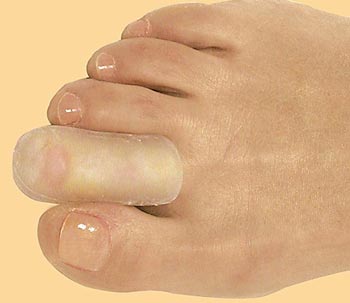
Creams and gels that remove calluses between the toes also contain acids. Additional components may include extracts of medicinal plants, essential oils, petroleum jelly and others. Before using the cream, the legs must be steamed, the drug is applied strictly to the problem area and fixed with a band-aid. The active components of the cream affect keratinization, promote softening and rejection of hard layers of skin. Auxiliary components have an anti-inflammatory and regenerative effect, caring for the skin and promoting its renewal.
Dry calluses between the toes can be removed using callus fluid. The drug is applied to a dry area once a day. Duration of application - until the keratinized surface is completely destroyed. The liquid dries quickly enough on the skin. It contains more than 90% of active components (alcohol and acids), which determines its high efficiency.
The patch we talked about in this article also helps with dry calluses.
How to treat a growth with a rod
It is almost impossible to cure a callus on your own, so it is better to immediately contact a specialist. This is due to the fact that such a formation can grow very deep inside, often affecting nerve endings and blood vessels.
Removal requires sterile conditions and the use of special surgical instruments. The doctor first cuts off the top layer of skin at the site of the lesion, after which he pulls out the root of the callus by drilling with a tool with a cutter. In addition to physical removal, the following procedures may be used:
- laser removal - most effective in advanced stages;
- cryotherapy - liquid nitrogen is used for removal.
How to remove a callus between your toes using traditional methods?
Much is known about how to cure calluses between the toes quickly using folk remedies. The possibilities of alternative medicine are wide and immense. Compresses, lotions, home-made ointments and creams, baths - the assortment is impressive. This review focuses on the most popular methods.
Hot baths
The feet are steamed using hot baths - soap and soda, salt, with the addition of potassium permanganate, herbal decoctions, essential oils. In any of these baths, the untreated dry callus will be thoroughly soaked, after which it should be thoroughly rubbed with a pumice stone. After the procedure, your feet should be wiped dry and treated with nourishing cream. In 7-10 baths, the callus between the toes will disappear completely.
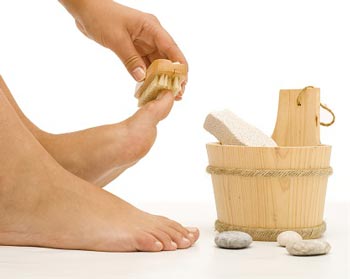
Natural compresses
Interdigital callus, treated by applying compresses, can heal in a few days. For compresses most often used:
- lemon juice;
- Castor oil;
- celandine crushed in a blender or its juice;
- grated potatoes;
- bread crumb soaked in vinegar;
- raw potato gruel;
- baked garlic;
- cut aloe leaf;
- crushed plantain leaf;
- gruel from calendula flowers;
- heated propolis and others.
The technology for applying all compresses is the same: the legs are pre-steamed, a gauze cloth is soaked in juice (or a slurry is applied to it) and applied to the callus, the leg is bandaged, and socks are put on for a more reliable fixation and to enhance the effect. Typically, all compresses are applied at night, and in the morning the softened layer is scraped off.
Another popular folk method is burning the callus with vinegar essence. With this method, nearby healthy tissues must be sealed with a band-aid, and the essence must be dripped exclusively onto the callus. This technology is similar in effectiveness to callus fluid. In both cases, burns are possible.
When the callus is old
In this case, before taking any action, you need to visit a doctor and get his advice. It is important to do this, because sometimes it is the fungus that causes the formation of such a problem as dry calluses between the toes. Treatment should take this fact into account.
If you neglect the doctor’s participation, you may encounter the fact that such a thickening of the stratum corneum will develop into a plantar wart, which you will definitely not be able to remove on your own.
Therefore, if dry calluses appear between the toes, it is better to initially carry out treatment in a cosmetology clinic. There they can be carefully and safely cut, after which they will be treated with liquid nitrogen.
To quickly and thoroughly neutralize this type of callus, the drilling method can also be used. This method is good because a new one will never appear in place of the removed growth.
How to remove a callus between toes with a rod?
The callus between the toes does not always respond to the above methods. It's all about the presence of a root that goes deep inside or even reaches the nerve endings, disrupting blood circulation and causing severe inflammation. To remove such calluses, there are highly effective special procedures that are performed in a doctor's office:
- drilling;
- laser method;
- cryodestruction.
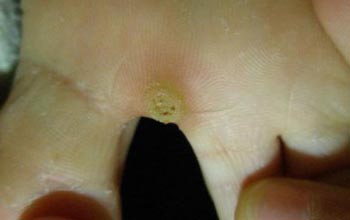
Drilling is carried out with a bur or cutter, the diameters of which correspond to the diameter of the callus core. The procedure is performed sterilely, using anesthesia. The cavity formed after drilling is treated with anti-callus liquid (to eliminate root remains) and an antiviral agent. One procedure is not always enough; some deeply ingrown calluses require multiple drillings until complete removal.
If treatment of calluses between the toes at home does not lead to results, they can be effectively removed using laser destruction. The laser beam evaporates dead cells, destroys microbes, which eliminates the risk of infection. Just one procedure is enough to ensure that not a trace remains of the callus between the toes. Within a couple of weeks, new smooth skin will replace the callus.
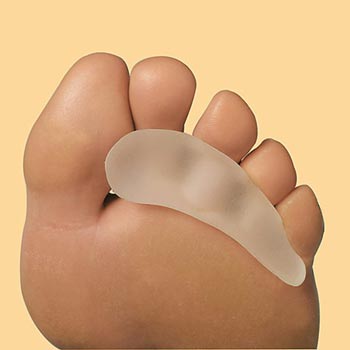
The cryodestruction method has a similar effect. The callus with the core between the toes is destroyed by freezing with liquid nitrogen. The procedure lasts only 30 seconds. It is during this time that deep freezing of the stratum corneum and root occurs, in place of which cryonecrosis is formed. After it is rejected, new skin is formed at the site of the callus in just 2 weeks. The procedure is painless and atraumatic.
The only drawback of the two above technologies is the high price.
What is dry callus?
If there is slight but regular friction of any part of the epidermis, a thickened layer of skin may form in this place. This is a dry callus.
Sometimes a dry callus turns into a callus with a core. It grows deep into the skin and reaches the main layer of the skin (dermis). The dermis is filled with nerve endings, which can make the callus very painful.
The appearance of an ingrown callus occurs when pathogenic microorganisms, such as bacteria, viruses, and fungi, penetrate into the microholes of a dry callus.
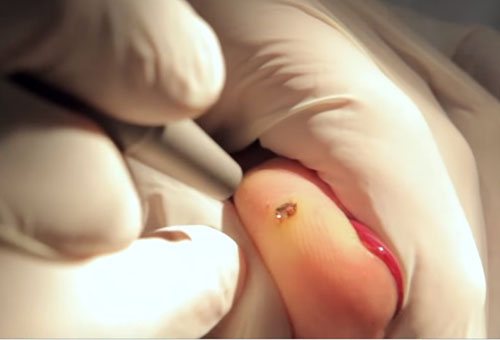
Prevention
Avoiding calluses is much easier than treating them. You just need to follow these recommendations:
- choose only high-quality shoes that fit in size (the heel must be stable and of optimal height, the fullness must be appropriate);
- at every opportunity, take off your shoes - take them off or change into comfortable house shoes;
- exclude (if possible) high heels, pointed shoes;
- use special stretching fluids in case of pressure or excessive compression of new shoes;
- Protect areas of greatest rubbing with special plasters and stickers;
- use interdigital inserts made of silicone or gel;
- in case of excessive sweating, it is necessary to use talcum powder or use other methods to combat moisture in the feet;
- take care of your feet in the evening with soothing baths and moisturizing creams containing oils;
- observe the rules of hygiene;
- get regular pedicures in a specialist’s office;
- monitor your weight;
- monitor the health.
If calluses have formed between your toes, the treatment will be tedious. But how easy it is to prevent their occurrence and devote your personal time to more enjoyable activities.
How to prevent thickening of the stratum corneum
Here is one of the first rules to remember: it is important to always choose comfortable and high-quality shoes for regular use. It must “breathe”, otherwise the toes may sweat excessively, which over time can lead to calluses.
If the shoes are new and put pressure on the foot, then you should use special stretching fluids that can correct this problem.
After a hard day of work, especially if you had to walk a lot, you need to use skin-soothing baths, for example, with chamomile infusion. Due to its beneficial properties, ichthyol ointment also deserves attention.
To prevent calluses from appearing between your toes, the treatment of which will still take time, it is better to initially set aside a few minutes during exercise for a short but quality rest. Such prevention will allow you to work actively and at the same time not be afraid of the appearance of skin layers.
Using baths
Let's consider what to do if calluses appear between the toes, how to get rid of them at home using folk recipes. Dry growths are best treated at the initial stage of development of the disease. In advanced cases and in the absence of effect from treatment with traditional methods, it is recommended to consult a specialist.
To remove a wet callus between your toes as quickly as possible, it is important to keep it intact and not to open the blister. The following home remedies are most effective:
- A mixture of furatsilin and hydrogen peroxide is applied every 2-3 hours. This solution dries the inflamed skin and disinfects, preventing infection.
- You can get rid of the growth using an egg. Its inner part of the shell is lined with a white film, which eliminates the blister due to its rich composition: it contains amino acids, vitamins and microelements that accelerate the healing of the upper layers of the epidermis.
Dry corns between the toes can be eliminated using numerous home remedies. They are easy to prepare and very effective.
- Steaming your feet and treating them with pumice is not only an excellent way to treat, but also to prevent the appearance of calluses. You can add salicylic acid to a bath of warm water, then the exposure time will be only 5-10 minutes, after which you can easily remove rough skin.
- Baths with sea or table salt also soften the skin well, preparing it for further manipulation. The duration of the procedure is 30-40 minutes, after which the steamed growth should be treated with a foot file. After cleansing, the legs should be rinsed in clean water, wiped dry and lubricated with nourishing cream. The course of therapy is 8-10 daily sessions until the callus is completely eliminated.
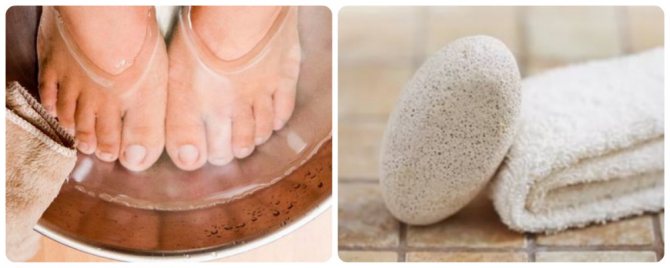
Foot steaming and pumice stone treatment
- The garlic-vinegar tincture is applied overnight; in the morning, the treated area must be thoroughly rinsed and cleaned with a pumice stone or a foot file. To prepare the medicine, you need to pour 3 cloves of garlic with 3 glasses of wine vinegar, put the container in a dark, cool place and let it brew for 3 weeks. A bandage or gauze is soaked in the prepared mixture and applied only to the painful area, then fixed on top with polyethylene and a bandage.
- A propolis compress softens calluses and can be used daily. A small cake of this product is stuck on with a patch overnight and applied until the growth is completely eliminated.
You can get rid of calluses between your toes by using warm foot baths with medicinal solutions. Using warm foot baths is considered one of the most effective and inexpensive methods. Special formulations help to greatly soften the rough skin of the feet, after which removing it from the surface is not difficult.
The following bath recipes are popular:
- Bath with soda and soap - take 800 ml of warm water, dissolve 1 large spoon of soda, soap your feet with laundry soap and place in a container with water.
- Salt bath with cool water to reduce pain - prepare 1 liter of water, dissolve 1 large spoon of coarse salt, place your feet in the bath.
- A bath with potassium permanganate is a product with an antibacterial effect, for the preparation of which you need to dissolve manganese in water until it turns pale pink, add a pinch of salt.
The procedure using any of the listed solutions should last from 15 to 20 minutes. After achieving the effect of softening the callus, it is necessary to carefully remove the surface layer of skin.
The use of this technique gives good results for such problems as calluses between the toes. Treatment with a photo of the process itself will allow you to better understand the essence of the procedure. But even without visualizing the actions, understanding the intricacies of preparing baths is not so difficult.
- Manganese bath. You need to make a light pink solution of potassium permanganate and add a little salt there, then put your feet in it for 15-20 minutes.
- Soap and soda. In 2 liters of hot water you need to dissolve 2 tbsp. l grated or liquid soap and 5 tsp. baking soda. You need to keep your feet in the resulting solution for 30-40 minutes. Then it is recommended to treat the compacted areas with pumice. To complete the procedure, a softening or nourishing cream is applied.
– Adding chamomile. The recipe described above can be slightly modified: in 1 liter of heated water, in addition to soda and soap, add 1 liter of chamomile infusion. The result is a 2-liter therapeutic bath. But before you put your feet in it, problem areas need to be rubbed with pumice. This effect on the callus should be applied at least once a week. When the layer turns white, it can be carefully removed.
- Salt bath. To prepare it, you will need to dissolve ordinary salt (2 tbsp) in 2 liters of water. You need to keep your feet in this solution at room temperature for half an hour, after which they should be rinsed with warm water.

